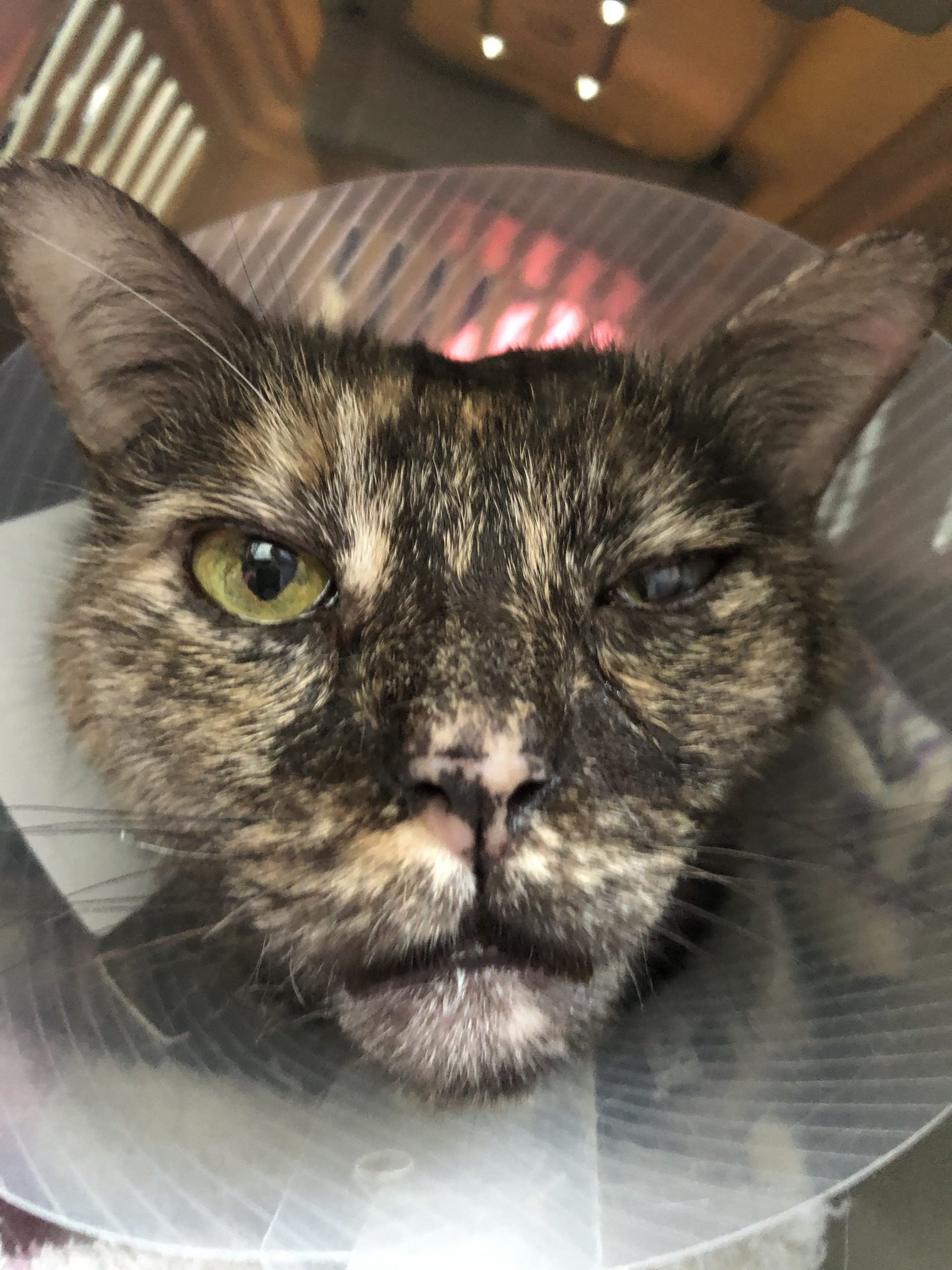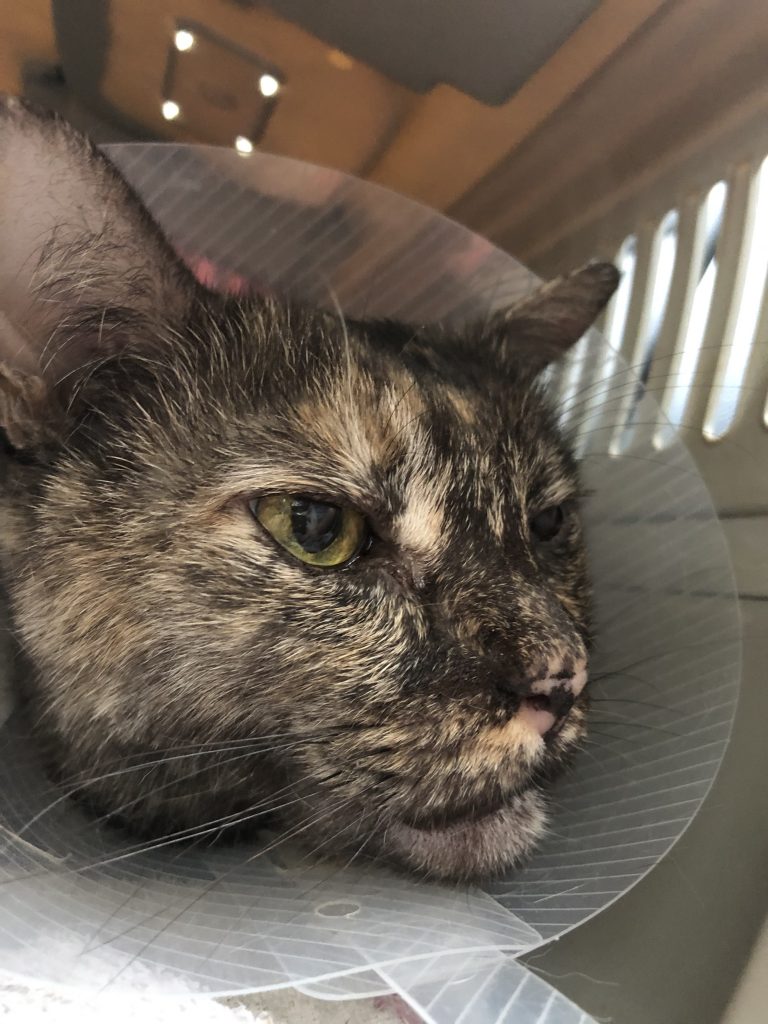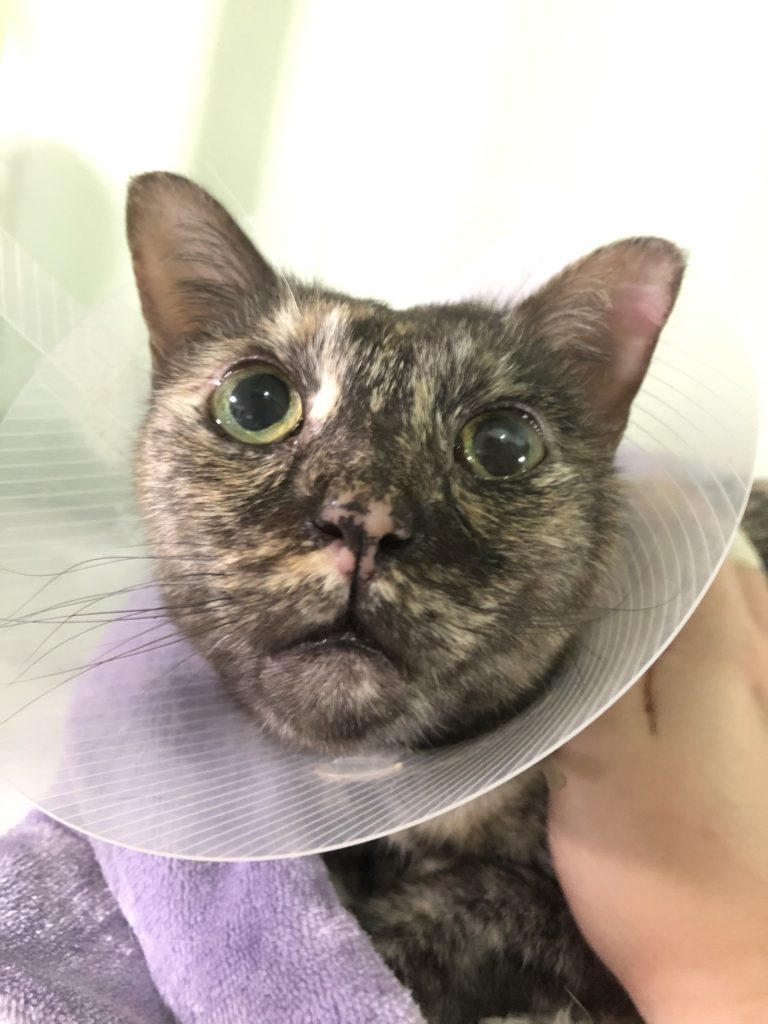
Allergies
Like humans, cats can have allergies too. They could happen in cats at any age and can be categorised into the following:
- Contact Allergy
- Drug Allergy
- Food Allergy
Contact Allergy
A cat may develop contact allergy when it comes into contact with chemicals such as detergents, soap, shampoos, plants, litter additives etc.
So far, I have had two encounters with contact allergies. Both times happened to Ning. I woke up one morning to find tufts of her hair strewn all over my living room. She looked flustered, darting about the house, constantly tugging fur out from her lower back. Her ears were bright pink and they felt hot to the touch. Her belly was also a shade darker than her usual pink. She was flicking her tail about and was visibly in distress. She also rejected her breakfast. I have never seen her behave in such a manner before. I called the clinic and was advised to bring her in for a consultation.
The vet took a look at her and confirmed that it was contact dermatitis. She advised me to give Ning a wipe down and to bathe her the next day to avoid stressing her out further as she already looked very stressed out by the trip to the vet. Ning was given an antihistamine (Cetirizine Dihydrochloride 10mg, Alzytec) to help reduce the itch and redness. It took roughly 30 minutes to see the effect. By the time we got home, around an hour later, she looked much more comfortable than before. She was no longer tugging at her fur. The redness had almost disappeared completely. She was eating, drinking and sleeping comfortably. In fact, her appetite increased tremendously. Usually she would only eat maybe 1/4 cup of kibbles for the entire day but after the antihistamine, she finished 1/2 cup of kibbles in a few hours. She also drank a lot of water on her own. The effect lasted until the end of the second day. I checked with the vet on this and she said that the antihistamine might have made her more hungry. I bathed her on the following day and she was fine for the next three days before her second episode.
The second time it happened, it was worse. Her ears turned dark pink. Everything happened very quickly. At first I suspected it was food allergy as I had given her a new type of food but the vet had said that this was unlikely because food allergy will usually cause facial swelling, vomiting or diarrhoea, itching, respiratory problems (although these are rare). Moreover, after wiping her, the itch and redness started to subside. However, I still fed her an antihistamine as a precaution. She got much better after the antihistamine.
I was told to find out the source of her contact allergy. The only thing I could think of was the white vinegar which I added to the water I used to mop the floor. I have been using white vinegar to clean the floor for years and all along she was fine with it. Seemed like her immunity had changed. This happens when they age. Things that they were fine with when they were young doesn’t mean that they will not be allergic to when they get older. The moment I stopped using the white vinegar, she was immediately rid of the allergy.
If your cat has contact allergy, you need to find out the source of the allergy quickly. For e.g. did you change a new brand of detergent or pet shampoo lately? Once you eliminate the source, the contact allergy should resolve.


Food Allergy
Food allergy can present in different ways. It might be an instant reaction or it might take some time to show symptoms. In an instant allergic reaction, your cat’s face may swell or it may have difficulty in breathing. Other allergy symptoms are likely vomiting, diarrhoea or red, itchy skin.
Ning’s food allergy also developed over time. I was feeding her Aixia canned food for a period of 8 to 9 months. Initially she was fine with the food. But 3 to 4 months into it, I noticed that she was coughing and vomiting more often. She has a history of asthma so I thought nothing much of her cough since that was the main symptom of asthma. Besides, she loved the food too much for me to stop her from eating. Surprisingly, she just decided not to have it anymore one morning, not sure why. Perhaps she grew sick of it, or she knew this food made her unwell. The strangest thing happened next. She started liking the brands she usually hated such as Royal Canin and Hills.
The frequency and intensity of her cough reduced substantially after stopping Aixia. From having 5 to 6 episodes of cough a day which lasted roughly 1 to 2 minutes, it reduced to around once to twice daily, each lasting about 30 seconds. Before stopping Aixia, she would cough till she wheezed. It was so bad I had to give her Theophylline on maximum dosage daily to help open her airways. Even after taking it, she would still cough. I felt helpless to watch her in so much discomfort. If the medicine didn’t work, she would have to be on steroids for the rest of her life. That might result in unwanted side effects to the other parts of her body, which is to me, a never-ending vicious cycle. Thankfully, we were fortunate to have discovered that the source of her cough was her food.
A lot of patience and perseverance is needed to find out the source of food allergy. One thing I learnt is to test out the flavours/brands of food one at a time and stick to it for at least 2 weeks to a month. I always caved in and gave her other flavours when she lost interest in her food. So I took a lengthy time to find out the source as I had to restart my trial. If she didn’t resolutely reject Aixia, I think I would have never found the cause.
Drug Allergy
Drug allergy is a menace, especially when the cat’s immune system is weak. A drug allergy can easily further weaken it and result in medical complications. For instance, Ah Mao’s immune system was already weakened by her chronic kidney disease. A drug allergy weakened it even more and resulted in a re-infection in her cornea due to FHV.
Drug allergy usually happens within 30 minutes after taking the drug. Some of the severe allergy symptoms include swelling in the face and difficulty in breathing. Once I brought Ah Mao for a visit to the vet as she had been nauseous and vomiting repeatedly due to her kidney problem. The vet suggested an injection of Ranitidine, a drug that was supposed to curb her nausea and stop her from vomiting. I was hesitant as Ah Mao had been having adverse reactions to new drugs in recent years. However, the vet assured me that this drug was relatively safe. In fact the purpose of it was to treat vomiting, thus unlikely to cause it. I took her advice and suggested staying there for half an hour to observe for possible drug allergy and we proceeded with the treatment.
After the injection, the vet left us in the room for observation while she attended to another patient. Within minutes after she left, Ah Mao started vomiting profusely. Her face started swelling as well. I never understood what doctors meant whenever they told me to look out for swelling in the cat’s face. With its fur, I thought it would be very difficult to tell if its face was swollen but after this encounter, I realised a swollen face was extremely obvious. Ah Mao’s chin swelled to triple its usual size. If your cat has a drug allergy and has a swollen face, don’t worry about not being able to tell. You won’t miss it. Ah Mao reminded me of Tigger with her swollen chin (refer to pics below). Now that I think of it, perhaps Tigger’s creator had a cat that suffered from drug allergy and it inspired the creation of this character. Hahahaha..
It took less than 5 minutes for her face to go into full blown swelling. I rushed to find the vet to come take a look. The moment she saw her, she said she had to give Ah Mao a steroid injection to treat her drug allergy. I was so worried that the second drug will cause further allergy but there’s no choice; I had to trust the doctor’s judgement. To give her a second injection minutes apart from the first was damn difficult. She was growling away, swatting at the nurse and doctor. Her agitation made her breathing even more shallow and rapid. Luckily, the nurse managed to hold her down using a towel, allowing the doctor to administer the injection successfully. The jab worked pretty quickly. Her vomiting stopped but we stayed for another 40 minutes for observation, just in case she gets allergic to the anti-allergy injection. Irony. She calmed down pretty quickly soon after the doctor and nurse left the room. Her breathing became normal and she was back to her curious self, exploring the doctor’s office.
Her chin was still swollen after an hour, although the swelling had subsided quite substantially. We were prescribed Chlorphenamine 4mg 1/4 tablet twice a day for her to take, in case the swelling didn’t go off by the next day. The rest of the day that she was home, she was sleeping a lot. This was expected since the drug might cause drowsiness. Thankfully by the next day, she was back to being active although I had to feed her one more day of Chlorphenamine since there was still a bit of swelling on her chin. It took a total of 2 days before it went away completely. One thing good that came out of this was that she didn’t vomit for a long while after this ordeal. (Read my post on feeding medicine to learn how to feed small tablets to cats)
When your kitty gets a drug allergy, it is bound to be stressful for the both of you. While your cat deal with the symptoms, you would likely be dealing with the guilt. Some people might blame themselves for letting their pets undergo treatment even though it was for their pet’s best interests. I was one of those. When I saw Ah Mao retching in the doctor’s room, I deeply regretted for agreeing to let her have the injection. What if she died from the allergy? She was already weak. If I had rejected the doctor’s suggestion, she wouldn’t have to go through all the discomfort. At that time, I felt stupid for going along with the doctor. The worst part was when my dad commented that I kept making Ah Mao go through “unnecessary” treatments. If I had left her alone, she might do just fine; I guess what he meant was if her time was up, then I should let her go naturally instead of intervening with so many medical treatments. That comment was harsh, mean and hurtful. I knew I shouldn’t be affected by it since it was just a passing remark but damn I couldn’t get it out my mind.
If you are in a similar situation as me, caught in a dilemma of not knowing whether you should let your kitty go for a treatment because you’re worried it might suffer a drug allergy, do not feel afraid to make that decision. Any outcome, be it good or bad, you made the decision based on your cat’s best interests. Therefore, you shouldn’t blame yourself even if the outcome is bad. I am sure your kitty would understand and not blame you. Ignore unconstructive comments by others especially if you are the main caregiver for your cat. They do not have the right to comment because you are the one putting in the time, effort and emotions into taking care of it. Do your own research, find a doctor whom you can trust. If you are skeptical about trying out a new drug, talk to the vet, find out if there are alternative ways. You have nothing to feel bad about if you have already done your best.
I guess you can try giving your cat some supplements to try to build up its immune system. For instance Viralys – L-Lysine or some omega 3 fish oil (I bought the brand Medicote). Hopefully with a stronger immune system, the likelihood of allergies will be reduced.









Love,
TG